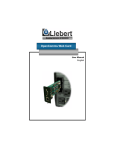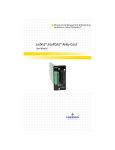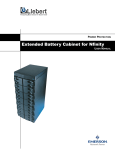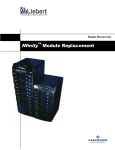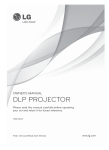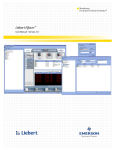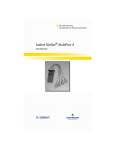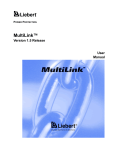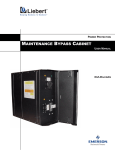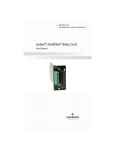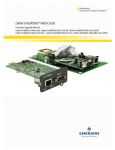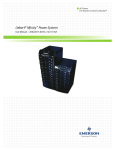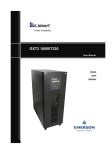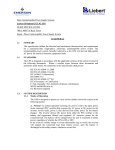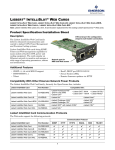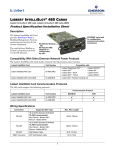Download SNMP Web Card.book
Transcript
Intellislot SNMP / Web Card TM TM for use with the PowerSure, GXT & Nfinity UPS ® User Manual English TABLE OF CONTENTS INTRODUCTION ..................................................................................... 1 About this User Manual ..................................................................... 1 About the Quick Start Guide ............................................................. 1 About the Text Formatting ................................................................ 1 Introduction ....................................................................................... 2 INSTALLATION ...................................................................................... 5 Installing the Card ............................................................................. 5 Connecting the Card to the Network ................................................. 5 Configuring the Card ......................................................................... 6 SERVICE TERMINAL ............................................................................. 7 Opening a Service Terminal Connection .......................................... 7 Main Menu ........................................................................................ 9 System Information Menu ............................................................... 10 Network Interface Menu .................................................................. 11 SNMP Communication Menu .......................................................... 13 Web Server Menu ........................................................................... 16 Firmware Updates Menu ................................................................. 17 Factory Settings Menu .................................................................... 18 WEB ...................................................................................................... 19 Opening a Web Connection ............................................................ 19 Connected Device Information ........................................................ 21 Security ........................................................................................... 22 Before clicking Save and Reboot .................................................... 23 After clicking Save and Reboot ....................................................... 24 Monitor Tab ..................................................................................... 26 Control Tab ..................................................................................... 28 Configure Tab ................................................................................. 29 Support Tab .................................................................................... 32 SNMP .................................................................................................... 33 APPENDICES ....................................................................................... 35 MultiLink Support ............................................................................ 35 Nfinity™ Support ............................................................................. 37 INTRODUCTION About this User Manual Welcome to the User Manual for the Intellislot SNMP/Web Card. This manual is available from Liebert's web site at www.liebert.com. The most recent version is always located online and you should consult the Web if you feel you have an older copy. About the Quick Start Guide In the Appendices, you will find a copy of the Quick Start Guide. The Quick Start Guide ships in the box with the Intellislot SNMP/Web Card and provides the most important information you need to install and configure of the card. It included with this manual for your reference. About the Text Formatting ·Whenever a Liebert product is referred to, the product name appears in Italics. ·Text from Service Terminal screens is shown using Courier. ·Text representing tabs and folders on the Web interface are show in bold. ·Text that you need to enter from the keyboard is also shown using Courier and the required text is in quotations. 1 Introduction The Intellislot SNMP/Web Card delivers SNMP (Simple Network Management Protocol) and Web support to the UPS in which it is installed. The card is designed for use in a Liebert UPS with an Intellislot bay. This includes the PowerSure Interactive, UPStation GXT, UPStation GXT2U, and Nfinity. The Intellislot SNMP/Web Card requires an Ethernet network connection and supports both 10Mbit and 100Mbit communication speeds and either half or full duplex. The Intellislot SNMP/Web Card enables in-band communication via the Web from computers running web browser software. The Intellislot SNMP/Web Card enables in-band communication with network management systems (NMS) via SNMP. The Intellislot SNMP/Web Card integrates with Liebert's MultiLink™ software to provide notification for unattended, graceful operating system shutdown of PCs, servers, and workstations. MultiLink is available for most operating systems. For more information on MultiLink and downloadable version of MultiLink software, please visit www.liebert.com. 2 INSTALLATION Installing the Card The Intellislot SNMP/Web Card is hot swappable and user-serviceable. You do not need to turn off the UPS, disconnect any loads, or restart the UPS to install or remove the card. CAUTION: The Intellislot Bay is located in close proximity to the UPS' output and the UPS' electrical receptacles. Whenever possible, you should turn the UPS OFF when installing the card. To install the card: 1.Locate the Intellislot bay on the back of the UPS. For Nfinity, use the Intellislot labeled "COM1". 2.Remove the plastic Intellislot cover and save the screws for Step 4. 3.Insert the Intellislot SNMP/Web Card into the Intellislot bay. 4.Secure the card with the screws you removed in Step 2. NOTE: The card is powered by the UPS during both normal and on battery operation. If the UPS is ON, the card will operate normally after a brief boot up period. Connecting the Card to the Network To connect the card to the network, simply plug an Ethernet cable to the RJ-45 connector on the card. The card supports 10Mbit and 100Mbit communication speeds at either half or full duplex. The card ships from the factory in an auto-sensing mode. In this mode, the card works to negotiate the optimal setting for your network environment. To turn off the auto-sensing mode and force the card's communication speed or duplex setting, you will need to open a Service Terminal connection to the card. Please refer to the Service Terminal section. 5 Configuring the Card The card ships from the factory with DHCP service enabled. The MAC address is located on the outside of the box and is also printed on a sticker affixed to the top of card. To give the card a static IP address, you will need to open a Service Terminal connection to the card. Please see the following section for more on the Service Terminal. 6 SERVICE TERMINAL Opening a Service Terminal Connection This section covers the Service Terminal in detail. From the Service Terminal, you can configure all settings of the card. NOTE: You can also configure many of the settings discussed in this section from the Web. To specify that the card communicate at either 10Mbit or 100Mbit instead of it trying to auto-negotiate, you must use the Service Terminal You access the Service Terminal by opening a direct serial connection to the Intellislot SNMP/Web Card. 1.Locate the blue serial configuration cable that shipped with the card. NOTE: If you have misplaced the cable provided, you can use a null modem cable with a DB-9F connector at both ends. 2.Connect one end of the blue serial configuration cable to the DB-9M serial port on the Intellislot SNMP/Web Card. 3.Connect the other end of the blue serial configuration cable to a terminal or a PC running terminal emulator software, like HyperTerminal™ or ProComm™. NOTE: If you are using a laptop or PC without any connected serial devices, your active serial port is most likely COM1. If you have the correct cable and are unable to open a connection, please confirm that you do not have a COM port conflict. 4.Use the following communication settings: BAUD RATE: DATA BITS: PARITY: STOP BITS: FLOW CONTROL: 9600 8 NONE 1 NONE 5. Press "Enter" to see the Main Menu. 7 If you do not see the Main Menu, press "Enter" again several times. If the Main Menu fails to appear, confirm that the blue configuration cable is installed properly, that your PC or terminal COM port is active, and that you are using the correct communication settings. If, after verifying the cable and your communication settings are correct you still do not see the Main Menu, reinstall the card in the Intellislot bay. NOTE: The card is powered by the UPS. If the UPS is ON, the card will operate automatically. If you have the cable connected while inserting the card, you will see initialization text scroll on your screen. If the card has already been powered, you will not see this information. 8 Main Menu From the Main Menu screen, you will find configuration information functionally grouped. Liebert Network Interface Card Main Menu ---------1: System Information 2: Network Interface 3: SNMP Communications 4: Web Server 5: Firmware Updates 6: Factory Settings q: Quit and abort changes x: Exit and save Please select a key ?> Changes you make using the Service Terminal will only take effect after the card reboots. Accordingly, you always need to return to the Main Menu screen after making any change(s) and then select either option "q" or "x". If you select option "q" your changes will be aborted and the card will retain its previous settings. If you select option "x" the card will reboot and restart with your changes. 9 System Information Menu Selecting option "1" from the Main Menu opens the System Information Menu. Liebert Network Interface Card System Information Menu -----------------------1: Name Data Room UPS 2: Contact Network Services x100 3: Location Building 2, Floor 4 4: Description Supporting Main Server <ESC>: Cancel menu level Please select a key ?> The System Information Menu contains four user-defined data fields. The Service Terminal will report Uninitialized where you have not entered personalized data. The System Information Menu allows you to enter useful location and contact information. The data in these fields is available via SNMP and is presented in the support tab on the Web page. A typical configuration includes: Selecting option "1" to assign a name to the UPS. Selecting option "2" to assign an administrative contact Selecting option "3" to assign location information. Selecting option "4" to assign a description. The Name field can be up to 255 characters in length. The Contact, Location, and Description fields can be up to 64 characters in length. If you have made a change, you need to press "Esc" to return to the Main Menu and then press "x" to exit and save changes. 10 Network Interface Menu Selecting Option "2" from the Main Menu opens the Network Interface Menu. Network Interface Menu ----------------------1: Speed/Duplex Auto 2: Boot mode DHCP IP Address 126.4.1.19 Netmask 255.255.255.0 <ESC>: Cancel menu level Please select a key ?> From the Network Interface Menu you can configure the Network settings of the card Select option "1" to change the communication speed of the card or the duplex setting. Please select a key ?> 1 Valid Selections: -----------------1. Auto 2. 10Mbs/Half Duplex 3. 10Mbs/Full Duplex 4. 100Mbs/Half Duplex 5. 100Mbs/Full Duplex Select Speed and Duplex Setting: The Speed/Duplex default setting is Auto and the card attempts to negotiate the optimal setting for your network environment. You can select a fixed setting for either 10Mbit or 100Mbit speed, at either full or half duplex. 11 Select option "2" to change Boot mode settings of the card. Valid Selections: -----------------1. Static 2. BootP 3. DHCP Select Boot Mode: Your Boot mode setting options are Static, BootP, and DHCP. The card ships from the factory with DHCP service enabled. DHCP allows the card to obtain an address dynamically from a DHCP server on your network. The card also supports BootP dynamic configuration. If you are using DHCP or BootP you may find want to configure your DHCP or BootP server with the MAC Address of the card so that the server always assigns the card a specific address. The MAC Address is printed on a sticker affixed to the top of the card. To assign the card a fixed IP address, you need to change the Boot mode to Static and then provide an IP Address, Netmask, and Default Route. Network Interface Menu ----------------------1: Speed/Duplex Auto 2: Boot mode Static 3: IP Address 126.4.1.102 4: Netmask 255.255.255.0 5: Default Gateway 126.4.1.1 If you have made a change, you need to press "Esc" to return to the Main Menu and then press "x" to exit and save changes. 12 SNMP Communication Menu Selecting Option "3" from the Main Menu opens the SNMP Communications Menu. Liebert Network Interface Card SNMP Communications Menu ------------------------1: Authentication Traps 2: Display/Modify Communities 3: Display/Modify Trap Communities 'no' <ESC>: Cancel menu level Please select a key ?> From the SNMP Communications Menu you can configure the SNMP settings and behavior of the card. Select option "1" to turn authentication traps on or off. Enter "y" to enable authentication traps. Enter "n" to disable authentication traps. Select option "2" to edit the list of devices you want to have access to the card via SNMP. Display/Modify Communities Menu -------------------------------1: 126.4.1.100 write MyCommunity <ESC>: Cancel menu level <a>dd <d>elete <e>dit Complex lines allowed. e.g. <a 198.1.1.1 write public> ?> The options "a" "d" and "e" allow you to manage your list of network devices with access to the card. These options can be used as a com13 plex instruction to add a single device, specify read/write access rights, and designate the Community String. For, example, entering: "a 126.4.1.200 read NewCommunity" adds device 126.4.1.200 to the community list. The menu will update: Display/Modify Communities Menu -------------------------------1: 126.4.1.100 2: 126.4.1.200 write read MyCommunity NewCommunity <ESC>: Cancel menu level <a>dd <d>elete <e>dit As you are adding communities, you need to consider access rights. Notice above, that 126.4.1.100 has write access when the device passes the correct Community String of MyCommunity. This means that this network device has both read and write access to the card, whereas 126.4.1.200 has only the ability to read information when providing the correct Community String. Devices with write access can control the UPS and reconfigure settings of the card. In order for a device you have added to the Communities Menu to also receive notification from the card via SNMP Traps for UPS alarms and condition changed, you also need to add the device to the Trap Communities Menu. See below for details. Select option "3" to edit the list of devices you want to receive traps from the card via SNMP. Display/Modify Trap Communities Menu ------------------------------------1: 126.4.1.100 MyCommunity <ESC>: Cancel menu level <a>dd <d>elete <e>dit Complex lines allowed. e.g. <a 198.1.1.1 public> ?> The options "a" "d" and "e" allow you to manage you list of network devices that will receive SNMP Traps from the card. These options can 14 be used as a complex instruction to add a single device and designate the Community String. For, example, entering: "a 126.4.1.200 NewCommunity" adds device 126.4.1.200 to the trap community list. The menu will update: Display/Modify Trap Communities Menu ------------------------------------1: 2: 126.4.1.100 126.4.1.200 MyCommunity NewCommunity <ESC>: Cancel menu level <a>dd <d>elete <e>dit It is important to remember that you will often need to add a network device to both the Communities Menu and the Trap Communities Menu for your SNMP implementation to work as designed. If you have made a change, you need to press "Esc" to return to the Main Menu and then press "x" to exit and save changes. 15 Web Server Menu Selecting Option "4" from the Main Menu opens the Web Server Menu. Web Server Menu ---------------1: Web Server 'enabled' 2: Change Username/Password <ESC>: Cancel menu level Please select a key ?> From the Web Server Menu you can enable/disable the Web functionality of the card and edit the User Name and Password, which regulate access to the Web control and configuration tabs. Select option "1" to turn the entire Web Server ON or OFF. NOTE: If you select disabled, the card will be totally inaccessible from the Web, although it will continue to operate as an SNMPonly agent. Select option "2" to edit the User Name or Password that must both be entered correctly to control the UPS or to change configuration settings of the card from the Web. The factory default User Name is “Liebert” and the Password is “Liebert”. Because this is a well-known username and password, you should change it as soon as possible. You can also change the User Name or Password from the Web. From the service terminal, you do not need to know the current User Name or Password to make a change. NOTE: When changing the Username of Password from the Service Terminal, it is possible to leave either field blank. If you omit either the Username or Password field, the Service Terminal will accept the input but it will set the response to the default of Liebert. If you have made a change, you need to press "Esc" to return to the Main Menu and then press "x" to exit and save changes. 16 Firmware Updates Menu Selecting Option "5" from the Main Menu opens the Firmware Updates Menu. Firmware Updates Menu ---------------------1: Initiate XMODEM session... <ESC>: Cancel menu level Please select a key ?> From the Firmware Updates Menu you can reload the firmware of the card. Please consult the instructions you downloaded or received with you new firmware version. 17 Factory Settings Menu Selecting Option "6" from the Main Menu opens Factory Settings Menu. Factory Settings Menu ---------------------1: Reset to Factory Defaults Manufacture Date OCT 27,2000 MAC Address 00-00-68-16-00-03 Serial Number 415981G101D2000OCT270003 <ESC>: Cancel menu level Please select a key ?> The Factory Settings Menu displays information you may be asked by Liebert Technical Applications Support and is the only electronic place you can access the MAC address on demand. From the menu, you also have the option of resetting all the settings of the card the factory default. Selecting "1" will likely cause the card to be inaccessible from the network so its use should be applied with caution. If you have made a change, you need to press "Esc" to return to the Main Menu and then press "x" to exit and save changes. 18 WEB Opening a Web Connection This section explains the Web interface in detail. From the Web, you can monitor and control the UPS in which the card is installed. You can also configure many settings of the card. NOTE: To specify that the card communicates at either 10Mbit or 100Mbit, instead of it trying to auto-negotiate, you must use the Service Terminal. You access the Web Interface of the Intellislot SNMP/Web Card by opening a direct web browser. The card utilizes functionality of Microsoft® Internet Explorer™ 5.0 or higher. Whenever possible, you should use the latest copy of IE. 1. Open Internet Explorer. 2. Enter the IP address or hostname of the card in the address line of your browser. The first page you will see every time you open a new Web connection to the card is the Power Flow folder in the monitor tab. After your browser connects, you will see a screen very similar to below: 19 You will notice that information on the Web page is grouped in Tabs and Folders. The card organizes similar information together in folders, and similar functions in tabs. Tabs: Across the top of the screen are four tabs: monitor, control, configure, and support. As the tab names suggest, different information is presented and different operations are available to you under each tab. Folders: Within each tab, you will see a different list of folders on left pane of your screen. Here, display, control, and configuration information is grouped logically. If, for example, you click the Input folder under the monitor tab, you will see only information about the UPS' input power. 20 Connected Device Information Clicking between the monitor, contol, configure, and support tabs gives you access to folder lists on the bottom of the left pane. Although the folder list changes, depending on the tab selected, the top portion of the left pane remains constant. In the top of the left pane, summary network and connected UPS status is always presented. The IP address of the card and the Liebert UPS model type is presented under Connected Device:. In this example, the Intellislot SNMP/Web Card is installed in a UPStation GXT 700VA UPS and has been assigned the IP address, 126.4.20.92. The current operating state of the UPS is presented under Connected Device Status: along with the most serious UPS alarm, if one is present. For our example above, the UPS is operating normally with good utility power. 21 Security By opening a connection to the Intellislot SNMP/Web Card, you are able to do three things. You can monitor the UPS. You can also configure, or reconfigure, network settings and access rights of the card. And finally, you can control the UPS in which it is installed. The card allows any user with access to the network segment on which it is installed to monitor the UPS. This means anyone on the segment can view the entire contents of the monitor and support tabs. The card restricts access to the folders in the control and configure tabs. When a user clicks on a folder, the are prompted to for a User Name and Password. The factory default User Name is "Liebert" and the Password is "Liebert". Because this is a well-known username and password, you should change it as soon as possible. If you have not made this change from the Service Terminal, you can do so from the Web. 22 Before clicking Save and Reboot Just as you discovered when using the Service Terminal, every time you make a configuration change, the card must reboot for that change to take effect. Making changes from the Web is the same. As you navigate between the card's web pages, you will notice that configuration screens include buttons with text Save and Reboot. As an example, the screen shot below shows the edit fields available under the configure tab when you select the Network folder: When you click any of the web page Save and Reboot buttons, the card saves any changes you have made and then restarts. During this time, the card is unavailable on the network. When this process begins, your web browser may be instructed to open a new page. 23 After clicking Save and Reboot Anytime you press a Save and Reboot button on any of the card's web pages, the card will reinitialize. During this time, the card is unavailable on the network. As the card reboots, it first begins communicating on the network and then establishes communications with the UPS in which it is installed. The card will present to you some helpful information during the period of time that it is restarting. You will usually see the following text after you click a Save and Reboot button: Redirecting due to user configuration change! This text will remain on the screen for several seconds. When the card serves this text to your web browser it also passes instructions for the browser to wait and then attempt to refresh. If, however, this text persists, you may need to manually click the browser's Refresh button. As the card continues the reboot process, you may see the following text displayed: Discovering connected device... Last updated: Monday ... This text is shown after the card has successfully connected to the network and is operating normally, but has yet to complete opening a connection to the UPS. As the card reboots, your active page may remain blank for a brief period of time, your web browser may give an unable to connect warning, or it may continue to display one of the messages above. Due to some timing issues with networks and static nature of browsers, you may need to click the browser's Refresh button. Your refresh will take you to the Power Flow folder in the monitor tab. NOTE: If the “Discovering connected device...” text persists, even after clicking the browser's Refresh button, and you are never presented a graphical UPS page, the card is receiving power and 24 operating properly but it is having problems communicating with the UPS. When you make changes to the network address setting of the card, your web browser will be redirected to the new address and the browser will open a new window. If you change from a Static IP address to either DHCP or BootP, you will receive the following warning. The card has rebooted to an unknown dynamic address! Please consult a network administrator for the address! You may know the address the card will be assigned by your BootP or DHCP server. In this case, simply enter that address into your web browser and reconnect. Logically, the card has no way of knowing what the new address will be if you change from Static to BootP or DHCP. Although this feature is made available to you from the Web, you should use caution when making the change. 25 Monitor Tab When you select the monitor tab, you are presented with Connected Device: and Connected Device Status: on the top of the left pane. The folder list is at the bottom of the pane under Device Information:. The first page you will see every time you open a new Web connection to the card is the Power Flow folder in the monitor tab. After your browser connects, you will see a screen very similar to below: From the monitor tab, you are able to view the parametric data of the UPS. The Power Flow folder provides a graphical representation of the current state of the UPS along with useful information about input, output, and battery voltages as well as battery runtime information. The Alarm folder provides a list or any present UPS alarms. 26 Clicking on the Battery, Output, Input, Bypass (not supported in PowerSure Interactive), or Internals folder replaces the summary data presented on the graphical power flow pane with a tabular view of the complete list of data points reported by the UPS. Clicking on the Input folder presents a screen similar to: In the tabular view data, like input voltage, that changes over time is grouped as a Parameter. Values, which are known to the UPS, like nominal input frequency, are reported in Information. Finally, condition parameters, like utility failed, are together in a table labeled, Condition. The list of data in each of these sections and folders varies across UPS product lines and sizes and will change depending on the UPS in which you have installed the card. 27 Control Tab When you select the control tab, you are presented with Connected Device: and Connected Device Status: on the top of the left pane. The folder list is at the bottom of the pane under Control Operations:. As detailed in the Web Security section, a Username and Password protect the folders in the control tab. From the control tab you can do things like turn the UPS' output ON or OFF. Each folder represents a different control behavior and this list will vary across UPS product lines and sizes. 28 Configure Tab When you select the configure tab, you are presented with Connected Device: and Connected Device Status: on the top of the left pane. The folder list is at the bottom of the pane under Configuration Categories:. As detailed in the Web Security section, a Username and Password protect the folders in the configure tab. When you click on a folder under Configuration Categories: you will be able to edit network and device settings, including SNMP community lists. The folder list is shown below: Device Info Clicking on the Device Info folder allows you to edit the Name, Contact, Location, and Description fields. Factory Defaults Clicking on the Factory Defaults folder allows you to reset the card to the factory settings. Network Clicking on the Network folder allows you edit the IP address, Subnet, and Default Route of the card. You are also able to change the boot mode setting of Static IP, DHCP, or BootP. 29 SNMP Clicking on the SNMP folder allows you to enable authentication traps. Clicking on the Access or Traps folder allows you to configure the devices you want to have access to the card via SNMP and devices you want to receive traps from the card. An example configuration in the Access folder is shown below: As you are adding communities, you need to consider access rights. Notice above, that 126.4.1.100 has write access when the device passes the correct Community String of MyCommunity. This means that this network device has both read and write access to the card, whereas 126.4.1.200 has only the ability to read information when providing the correct Community String. Devices with write access can control the UPS and reconfigure settings of the card. In order for a device you have added to the Access folder to also receive notification from the card via SNMP Traps for UPS alarms and condition changeds, you also need to add the device to the Traps folder. 30 Users Clicking on the Users folder allows you to edit the Username or Password that must both be entered correctly to control the UPS or change configuration settings of the card from the Web. The factory default User Name is “Liebert” and the Password is “Liebert”. Because this is a well-known username and password, you should change it as soon as possible. You can also change the Username or Password from the Service Terminal. From the Web, you need to know the current Username and Password to make a change. Web Clicking on the Web folder allows you to modify the Web browser refresh rate. Due to the static nature of the Web, the card instructs your Web browser to refresh many areas of the card's web page at a specific interval. 31 Support Tab When you select the support tab, you are presented with Connected Device: and Connected Device Status: on the top of the left pane. A single device list is at the bottom of the pane under Support:. The support tab displays the Name, Location, and Description fields as well as relevant contact information for Liebert Technical Applications Support team. 32 SNMP The Intellislot SNMP/Web Card utilizes a SNMPv1 agent and is MIB-II compliant. The card supports the open standard UPS MIB, RFC1628, and augments needed functionality in the proprietary Liebert Global Products MIB. A copy of the Liebert Global Products MIB on CD is included in the box with the card. 33 APPENDICES MultiLink Support The most frequently asked question about configuring MultiLink to monitor a SNMP device, like the Intellislot SNMP/Web Card, across the network is, what community string do I use? NOTE: Use the community string “LiebertEM” for MultiLink. Configuring for MultiLink support from the Service Terminal From the Main Menu, select option "3" for SNMP Communications Menu. In order for MultiLink to monitor the card, the network address information of the machine on which MultiLink is installed needs to be added to both the Display/Modify Communities and the Display/Modify Trap Communities. As an example, you have installed MultiLink on a PC and you will monitor, across the network, the Intellislot SNMP/Web Card you are now installing. Your PC has the IP address of 126.4.1.1. ·Select option "2" from the SNMP Communications Menu and add 126.4.1.1 with the community string “LiebertEM”. ·Select option "3" from the SNMP Communications Menu and add 126.4.1.1 with the community string “LiebertEM”. If you have made a change, you need to press "Esc" to return to the Main Menu and then press "x" to exit and save changes. Adding to both the Communities list and the Trap Communities list is necessary for MultiLink to work properly. Configuring for MultiLink support from the Web Open a web connection to the Intellislot SNMP/Web Card. Click on the Configure tab. In order for MultiLink to monitor the card, the network address information of the machine on which MultiLink is installed needs to be added to both the Access and Traps folders. 35 As an example, you have installed MultiLink on a PC and you will monitor, across the network, the Intellislot SNMP/Web Card you are now installing. Your PC has the IP address of 126.4.1.1. ·Select option "2" from the SNMP Communications Menu and add 126.4.1.1 with the community string “LiebertEM”. ·Select option "3" from the SNMP Communications Menu and add 126.4.1.1 with the community string “LiebertEM”. 36 Nfinity™ Support The Intellislot SNMP/Web Card presents additional information on the Power Flow folder when installed in a Nfinity. Because the Nfinity is a redundant and scalable UPS, it is important to know exactly what is installed in its bays. The additional Power Flow table shows the maximum VA rating of the Nfinity frame along with information about installed Control, Power, and Battery modules. You will also find Nfinity-specific parameters used for SNMP alarming and status in the Liebert Global Products MIB. 37 Intellislot SNMP / Web Card TM TM for use with the PowerSure, GXT & Nfinity UPS ® The Company Behind the Products With over a million installations around the globe, Liebert is the world leader in computer protection systems. Since it’s founding in 1965, Liebert has developed a complete range of supportand protection systems for sensitive electronics: • • • • • Environmental systems: close-control air conditioning from 1.5 to 60 tons. Power conditioning and UPS with power ranges from 250 VA to more than 1000 kVA Integrated systems that provide both environmental and power protection in a single, flexible package. Monitoring and control - from systems of any size or location, on-site or remote. Service and support through more than 100 service centers around the world, and a 24/7 Customer Response Center. While every precaution has been taken to ensure accuracy and completeness of this literature, Liebert Corporation assumes no responsiblity and disclaims all liability for damages resulting from use of this information or for any errors or omissions. © 2001 Liebert Corporation. All rights reserved throughout the world. Specifications subject to change without notice. ® Liebert and the Liebert logo are registered trademarks of Liebert Corporation. All names refered to are trademarks or registered tradmarks of their repective owners. SL-52610 (1/01) Rev. 0





































